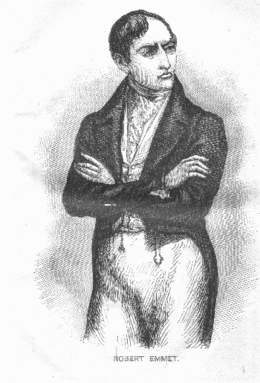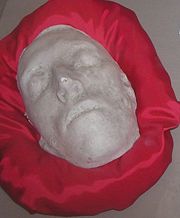Robert Emmet
| Robert Emmet Roibéard Eiméid |
|
|---|---|
| 4 March 1778 - 20 September 1803 | |

|
|
| Place of birth | Dublin, Ireland |
| Place of death | Thomas Street, Dublin |
| Allegiance | United Irishmen Napoleonic Empire |
| Years of service | 1793-1803 |
| Rank | Commander |
| Battles/wars | 1798 Rebellion 1803 Rebellion |
| Relations | Thomas Addis Emmet |
Robert Emmet, Roibéard Eiméid (4 March 1778 – 20 September 1803) was an Irish nationalist rebel leader. He led an abortive rebellion against British rule in 1803 and was captured, tried and executed.
Contents |
Early life
Emmet was born in Dublin, Ireland in 1778. His father served as surgeon to the Lord Lieutenant of Ireland and to members of the British Royal Family on their visits to Ireland. Despite his privileged position in Irish society Emmet, like many of his contemporaries, was attracted to revolutionary republican politics.
He was educated at Trinity College, Dublin, where he joined the patriotic society, the Society of United Irishmen who had initially campaigned for parliamentary reform and an end to religious discrimination against Catholics (though Emmet and many United Irishmen were Protestants). However, when the United Irishmen were banned following the British declaration of war on Revolutionary France in 1793, the organisation was forced underground and now aimed after full Irish independence, preparing for insurrection with French aid. Robert Emmet's brother Thomas Addis Emmet was a senior member of the United Irishmen and had to flee for France to escape prosecution for treason. The rebellion of 1798 was crushed but Emmet and others sought exile in France, joining the groups of emigre revolutionaries in Paris.
In 1802, during a brief lull in the Napoleonic Wars, Emmet joined an Irish delegation to Napoleon asking for support. However the delegation returned to Ireland without having succeeded in gaining Napoleon's backing.
1803 rebellion

When European conflict was renewed in May 1803, Emmet returned to Ireland and together with other revolutionaries such as Thomas Russell and James Hope, prepared to launch a new rebellion. Emmet began to manufacture weapons and explosives at a number of premises in Dublin and even innovated a folding pike which could be concealed under a cloak, being fitted with a hinge. Unlike in 1798, the preparations for the uprising were successfully concealed, but a premature explosion at one of Emmet's arms depots killed a man and forced Emmet to bring forward the date of the rising before the authorities' suspicions were aroused.
Emmet was unable to secure the help of Michael Dwyer's Wicklow rebels and many Kildare rebels who had arrived turned back due to the scarcity of firearms they had been promised but the rising went ahead in Dublin on the evening of July 23, 1803. Failing to seize Dublin Castle, which was lightly defended, the rising amounted to a large-scale riot in the Thomas Street area. The Lord Chief Justice of Ireland, Lord Kilwarden, chief prosecutor of William Orr in 1797, but also the judge who granted habeas corpus to Wolfe Tone in 1798, was dragged from his carriage and hacked to death. Emmet personally witnessed a dragoon being pulled from his horse and piked to death, the sight of which prompted him to call off the rising to avoid further bloodshed.
Emmet's fate

Emmet fled into hiding but was captured on 25 August, near Harold's Cross. He endangered his life by moving his hiding place from Rathfarnam to Harold's Cross so that he could be near his sweetheart, Sarah Curran. He was tried for treason on 19 September; the Crown repaired the weaknesses in its case by secretly buying the assistance of Emmet's defense attorney, Leonard Macnally, for £200 and a pension. However his assistant Peter Burrowes could not be bought and pleaded the case as best he could.
After he had been sentenced Emmet delivered a speech, the Speech from the Dock, which is especially remembered for its closing sentences and secured his posthumous fame among executed Irish republicans. However no definitive version was written down by Emmet himself.
| “ | Let no man write my epitaph; for as no man who knows my motives dare now vindicate them, let not prejudice or ignorance, asperse them. Let them and me rest in obscurity and peace, and my tomb remain uninscribed, and my memory in oblivion, until other times and other men can do justice to my character. When my country takes her place among the nations of the earth, then and not till then, let my epitaph be written. I have done.[1] | ” |
An earlier version of the speech was published in 1818, in a biography on Sarah Curran's father John, emphasizing that Emmet's epitaph would be written on the vindication of his character, and not specifically when Ireland took its place as a nation. It closed:[2]
- "I am here ready to die. I am not allowed to vindicate my character; no man shall dare to vindicate my character; and when I am prevented from vindicating myself, let no man dare to calumniate me. Let my character and my motives repose in obscurity and peace, till other times and other men can do them justice. Then shall my character be vindicated; then may my epitaph be written."
On 19 September, Emmet was found guilty of high treason, and therefore Chief Justice Lord Norbury's death sentence required that Emmet was to be hanged, drawn and quartered.
The following day, 20 September, Emmet was executed in Thomas Street. He was hanged and then beheaded once dead. [1]
The remains were then secretly buried. The whereabouts of his remains has remained a mystery.[3] It was suspected that it had been buried secretly in the vault of a Dublin Anglican church. When the vault was inspected in the 1950s a headless corpse that could not be identified, but which was suspected of being Emmet's, was found. In the 1980s the church was turned into a night club and all the coffins removed from the vaults. What was done with the mysterious corpse is unknown.
Legacy
Although Emmet's rebellion was a complete failure, he became an heroic figure in Irish history. His speech from the dock is widely quoted and remembered, especially among Irish nationalists.[3][4][5] Emmet's housekeeper, Anne Devlin, is also remembered in Irish history for enduring torture without providing information to the authorities.[3]
Robert Emmet wrote a letter from his cell in Kilmainham Jail, Dublin on 1803-09-08. He addressed it to "Miss Sarah Curran, the Priory, Rathfarnham" and handed it to a prison warden, George Dunn, whom he trusted to deliver it. Dunn betrayed him and gave the letter to the government authorities, an action that nearly cost Sarah Curran her life. His attempt to hide near Sarah Curran, which cost him his life, and his parting letter to her made him into a romantic character, which appealed to the Victorian Era's appetite for Romanticism, which prolonged his fame.
His story became the subject of stage melodramas during the 19th century, most notably Dion Boucicault's hugely inaccurate 1884 play Robert Emmet, inaccuracies including Emmet and Sarah being portrayed as Roman Catholics, John Philpot Curran being portrayed as a Unionist, and Emmet being killed onstage by firing squad.
Robert's friend from Trinity College, Thomas Moore, championed his cause by writing hugely popular ballads about him and Sarah Curran, such as
- "Oh breathe not his name! let it sleep in the shade,
- Where cold and unhonoured his relics are laid!"
and
- "She is far from the land where her young hero sleeps
- And lovers around her are sighing."
Washington Irving, one of America's greatest early writers, devoted "The Broken Heart" in his magnus opus The Sketch Book of Geoffrey Crayon to the romance between Emmet and Sarah Curran, citing it as an example of how a broken heart can be fatal.
Robert Emmet's older brother, Thomas Addis Emmet would emigrate to the United States shortly after Robert's execution and would eventually serve as the New York State Attorney General. His great-grand-nieces are the prominent American portrait painters Lydia Field Emmet, Rosina Sherwood Emmet, Jane Emmet de Glehn and Ellen Emmet Rand. Robert Emmet's great-great nephew was the American playwright Robert Emmet Sherwood.
Places named after Emmet include Emmetsburg, Iowa, Emmet County, Iowa, and Emmet County, Michigan.[4] There is a statue of Emmet in front of the under-construction Academy of Science, in Golden Gate Park in San Francisco.
See also
- List of people on stamps of Ireland
References
- ↑ Speeches from the Dock, T.D., A.M., and D.B. Sullivan, Re Edited by Seán Ua Cellaigh, M.H. Gill & Son, Dublin, 1953 pg.60
- ↑ Phillips, C. Recollections of Curran (1818 Milliken, Dublin) pp.256-259.
- ↑ 3.0 3.1 3.2 Sean Murphy (2003-09-20). "Irish Historical Mysteries: The Grave of Robert Emmet".
- ↑ 4.0 4.1 "A Small Town Struggles to Preserve Its Irish Heritage". Irish America Magazine Sept/Oct. 1993.
- ↑ Ruán O’Donnell (July 2003). "Robert Emmet: enigmatic revolutionary". Irish Democrat.
Bibliography
- Elliott, Marianne. Robert Emmet: The Making of a Legend
- Geoghegan, Patrick. Robert Emmet: A Life (Gill and Macmillan) ISBN 0-7171-3387-7
- Gough, Hugh & David Dickson, editors. Ireland and the French Revolution
- McMahon, Sean. Robert Emmet
- O Bradaigh, Sean. Bold Robert Emmet 1778-1803
- O'Donnell, Ruan. Robert Emmet and the Rebellion of 1798
- _____. Robert Emmet and the Rising of 1803
- _____. Remember Emmet: Images of the Life and legacy of Robert Emmet
- Smyth, Jim. The Men of No Property: Irish Radicals and Popular Politics in the Late Eighteenth Century
- Stewart, A.T.Q. A Deeper Silence: The Hidden Origins of the United Irish Movement
External links
- History of Dublin Castle, Chapter 13. Emmet's execution
- Irish Historical Mysteries: The Grave of Robert Emmet
- The (Show?) Trial of Robert Emmet, by Justice Adrian Hardiman (Supreme Court of Ireland), History Ireland , Vol. 13 No. 4, July/August 2005
- DNA tests to tell if skull is Emmet's
- Emmet's 'Proclamation of Independence'
- Robert Emmet's Speech from the dock
- Bronze sculpture of Robert Emmet (1916), by Jerome Stanley Connor, in Emmet Park, Washington, DC (photos)
- Éamon De Valera unveils statue of Robert Emmet in Golden Gate Park, San Francisco, July 20, 1919